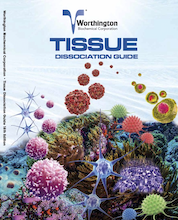For our international customers, please be advised that orders cannot be placed through our website by customers in countries with International Distributor representation.
Worthington Tissue Dissociation Guide
Optimization Techniques: General Guidelines
Although optimization of a cell isolation procedure for a particular cell type is dependent upon the adequate recovery of cells having various required characteristics, some guidelines can be established. The information in this guide regarding cell isolation and the enzymes used, when combined with logic and suitable experimental design, should lead to the development of a satisfactory cell isolation method. (See Freshney 1987 for a detailed discussion.)

The complex relationship between cell yield and viability can be represented by the simplified illustrations shown on the left. In general there is an area of optimized recovery balanced between yield and viability; working near the middle of this range will reduce variability in the results of the cell isolation procedure. Understanding this relationship and how it can vary with a particular cell type and application, can make the optimization process easier.

For troubleshooting purposes various possible results, along with suggested corrective actions are listed below. Keep in mind that there are no clear lines between the quadrants but rather converging zones with variable areas of overlap.
| Low yield/Low Viability | Over/under dissociation, cellular damage. Change to less digestive type enzyme and/or decrease working concentration. (e.g. from trypsin to collagenase/ from Type 2 collagenase to Type 1). |
| Low Yield/High Viability | Under dissociation. Increase enzyme concentration and/or incubation time and monitor both yield and viability response. If yield remains poor, evaluate a more digestive type enzyme and/or the addition of secondary enzyme(s). |
| High Yield/Low Viability | Good dissociation, cellular damage. Enzyme overly digestive and/or at too high a working concentration. Reduce concentration and/or incubation time and monitor yield and viability response. Try diluting the proteolytic action by adding bovine serum albumin (BSA) (0.1 - 0.5% w/v) or soybean trypsin inhibitor (0.01 - 0.1% w/v) to the dissociation. Try using less proteolytic enzyme although yield may be affected and should be monitored. |
| High Yield/High Viability | The place to be. Consider evaluating the effect of dissociation parameters to learn their limitations for future reference. |
A scale showing the relative digestive power of the enzymes commonly used follows for reference. Refer to this scale when troubleshooting a dissociation and planning isolation strategy.
Tissue Tables
The Worthington Tissue Tables provide references useful to researchers interested in tissue dissociation and cell harvesting procedures. The references are organized by Tissue and Species type and linked to PubMed citations. The Cell type, Enzymes, and Medium for each reference is provided.
To search by specific criteria, use the Tissue References Search Tool.

